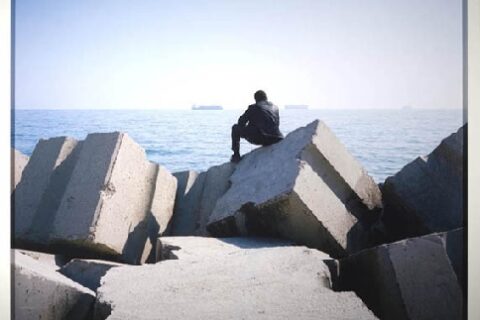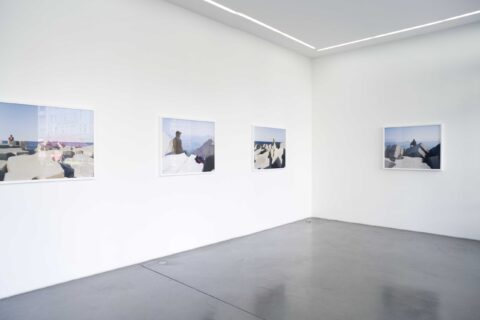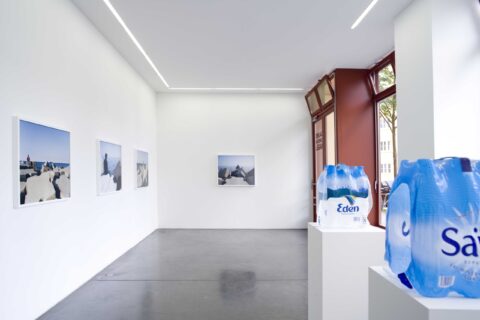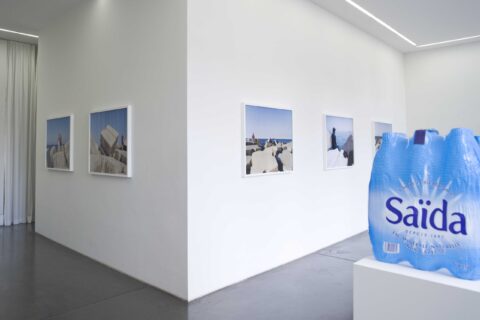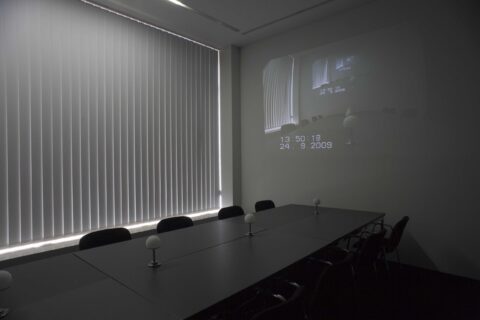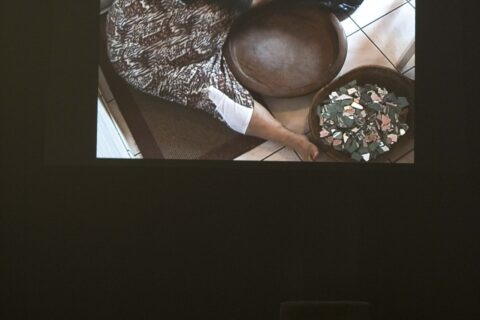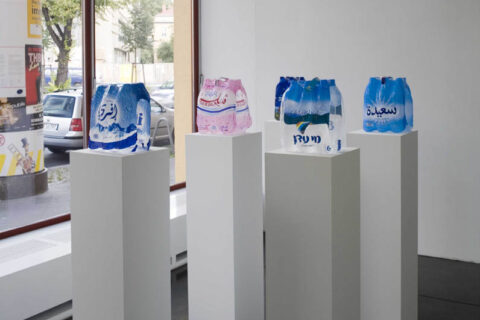Kader Attia As a fold, Horizon is not a space
22/09/2009 – 31/10/2009
Eröffnung: 21. September 2009, 19-22
Ausstellung: 22. September - 31. Oktober 2009

„As a fold, Horizon is not a space“, 2009
Ausstellungsansicht
Galerie Christian Nagel, Berlin
Foto: Ludger Paffrath
„As a fold, Horizon is not a space“, 2009
Ausstellungsansicht
Galerie Christian Nagel, Berlin
Foto: Ludger Paffrath
„As a fold, Horizon is not a space“, 2009
Ausstellungsansicht
Galerie Christian Nagel, Berlin
Foto: Ludger Paffrath
„As a fold, Horizon is not a space“, 2009
Ausstellungsansicht
Galerie Christian Nagel, Berlin
Foto: Ludger Paffrath
„Untitled“ (Conference table), 2009
mixed media
Foto: Ludger Paffrath
„Couscous Aftermaths“ (3000 years old movements), 2009
Video
Foto: Ludger Paffrath
„Rochers Carrés“, 2009
C-print
78,5 x 98,5 cm (unframed)
83,5 x 103,5 cm (framed)
Foto: Ludger Paffrath
„Rochers Carrés“, 2009
C-print
78,5 x 98,5 cm (unframed)
83,5 x 103,5 cm (framed)
Foto: Ludger Paffrath
„Rochers Carrés“, 2009
C-print
78,5 x 98,5 cm (unframed)
83,5 x 103,5 cm (framed)
Foto: Ludger Paffrath
„Rochers Carrés“, 2009
C-print
78,5 x 98,5 cm (unframed)
83,5 x 103,5 cm (framed)
Foto: Ludger Paffrath
„Rochers Carrés“, 2009
C-print
78,5 x 98,5 cm (unframed)
83,5 x 103,5 cm (framed)
Foto: Ludger Paffrath
„Rochers Carrés“, 2009
C-print
78,5 x 98,5 cm (unframed)
83,5 x 103,5 cm (framed)
Foto: Ludger Paffrath
„Untitled“ (No Water), 2009
plastic
Foto: Ludger Paffrath
„Untitled“ (No Water), 2009
plastic
Foto: Ludger Paffrath
Press Release
In seiner Ausstellung „As a fold, Horizon is not a space“ in der Galerie Christian Nagel Berlin, arbeitet Kader Attia mit ambivalenten Bedeutungen und Umkehrungen des Begriffs des „Horizonts“, als einer (in weiter Ferne – so nahen) Projektion des Immaginären einerseits und einer endlosen Verschachtelung von „Innenperspektiven“ andererseits.
Während die Arbeit „Rochers Carrés“, die aus einer Serie von Fotografien besteht, die Menschen an der Algerischen Küste bei ihrem Blick übers Meer festhält, den Moment des „wishful thinking“ nach der anderen „besseren“ Seite (Europa) einfängt, zeigt die Installation Untitled (conference room) eine leere Spiegelung von „Horizonten“ als Kurzschluss einer Überwachungskamera. Mit der auf diese Weise symbolisierten Abwesenheit von „innerer“ und „äußerer“ Wahrheit, stellen diese Arbeiten zwei Identitätsmodelle der Moderne in Frage: das des selbst bestimmten Individuums und das des Nationalstaates als Ort von Gemeinschaft.
Eine Videoarbeit im hinteren Raum der Galerie, die die Mutter des Künstlers zeigt, während sie aus Spiegelscherben Cous Cous bereitet, verbindet die beiden „Horizonte“ in einem zwischen Lokalem und Globalem, zwischen Individuellem und Kulturellem oszillierenden Imaginären.
Kader Attia ist algerischer Abstammung und wurde 1970 in Paris geboren.
_________________________________
In his exhibition „As a fold, Horizon is not a space“ at Galerie Christian Nagel Berlin, Kader Attia works with the ambivalent meanings of the theme of „horizon“, as (a far away – so close) projection of the imaginary, of wishes and hopes on the one hand and as the total endless „introspection“ of inner spaces on the other.
While the works of „Rochers Carrés“, photographs of people sitting in a field of concrete blocks on the Algerian Shore facing the sea, captures the moment of projection, of wishful thinking of the „other side“ with all its political inclinations of migration and identity, the installation Untitled (conference room) shows an empty introspection of „horizons“ as a short circuit of „surveillance“. The absence of both, an „inner“ as well as an „outer truth“, questions the modern concept of the „individual“ as a self dependent unit as well as the modern concept of the „nation“ as a place of the community. A video work in the back room of the gallery, showing the artists mother making Cous Cous from pieces of broken mirrors, merges the two „horizons“ in an oscillating imaginary of the local and the global, the individual and the cultural.
Born in Paris in 1970 into Algerian family, Attia’s work is heavily influenced by his cultural heritage. It is rooted in the complex relations between the East and West and deals with many different subjects from the place of women in religion; the taboo relations between power, religion and art; to the phobias, frustrations and fantasies of the human being. Attia is unafraid of tackling questions of globalisation and religion and his work presents a sometimes darkly humorous and even cynical view of modern life. It exists at the meeting point between Western consumerism and an uprooted North African culture and addresses issues of community, diversity, belonging and exile. Through his work Attia suggests that we are affected by both the physical and unconscious elements that surround us with which we have to live. Shape and meaning are always linked in his work, in a complex reflection that is rooted in art histories and the symbolic dimension of everyday objects. Attia produces work that is very simple in form but leads us into a fundamental dialogue – and holds up a mirror to challenge everyone who looks.
The first solo exhibition of Kader Attia took place in 1996 in the Democratic Republic of Congo. Since this exhibition, Attia has exhibited regularly in France, particularly in institutions like the Palais de Tokyo and the Lyon Contemporary Art Museum. Attia has gained international recognition by participating the Venice Biennale (2003), Art Basel Miami (2004) and the Lyon Biennale (2005) where he created his famous piece ‘Flying Rats’, an installation consisting of children puppets made from birdseed and living pigeons eating on them. Attia’s previous work also includes „La Piste d'atterrissage“, or „The Landing Strip“, which is a culmination of his work with Algerian transsexuals as they worked to try and find a place within wider French society.
His most recent solo exhibitions have been at Musée d'Art Contemporain de Lyon, France, Galerie Christian Nagel, Berlin, Germany, ICA Boston, USA, The International Art Biennial Tel Aviv 2009, a.o. He is the designer for the new Ballet production of Mark Baldwin’s Rambert Dance Company „Featuring the Comedy of Change“ and the winner of the Abraaj Capital Art Prize 2010. Apart from that Kader Attia will take part in the 2010 Smithsonian Institution Artist Research Fellowship Program.
ROCHERS CARRÉS
On an Algerian shore, massive concrete blocks pile, clustered in the sand. The local youths call this beach „Rochers Carrés“ („Square Rocks“), and in a series of photographs by the same name produced in 2008 by Kader Attia, the French artist of Algerian descent surveys this environment of assembled gray, sandy blocks and the vast expanses of blue sea and sky beyond them. In the artist’s observation, these cubic forms seem to mimic the ubiquitous and persistent forms of the housing edifices of the „banlieue“of the outer zones of Paris, where Attia grew up. The artist goes on to posit that the young Algerians who sit amongst these colossal forms and gaze out across the sea may not be thinking only of their present lives in the city of Algiers, but that they also might be contemplating that place across the Mediterranean – Europe – and their dream of the „better“lives that may be found there. Spending time in France and Algeria allows Attia to perceive a myriad of social and cultural characteristics of both locals, and to draw apt comparisons, such as the one between the positions of the young people who gather at Rochers Carrés and those in the Parisian suburbs – the struggles faced by both, the questioning of hope for the future – which offers a sensitive juxtaposition of lived experiences.
Spatiotemporal constellation has been a consistent mode of address for Attia. In his practice, including works on paper, sculpture, photography and large-scale installation, Attia mines the experimental dimensions of place, exploring specific ritual and cultural artefacts that also imply comparisons among current and historical societies. Through repetitive formal motifs and charged symbols, Attia explores notions of community and belonging. His works recall memories and desires associated with particular places and moments, and at the same time they reference the resonating effects of experience across perceived spatial and temporal boundaries.
(in: Time Out Of Joint. Recall and Evocation in Recent Art. Whitney/Yale, 2009)
